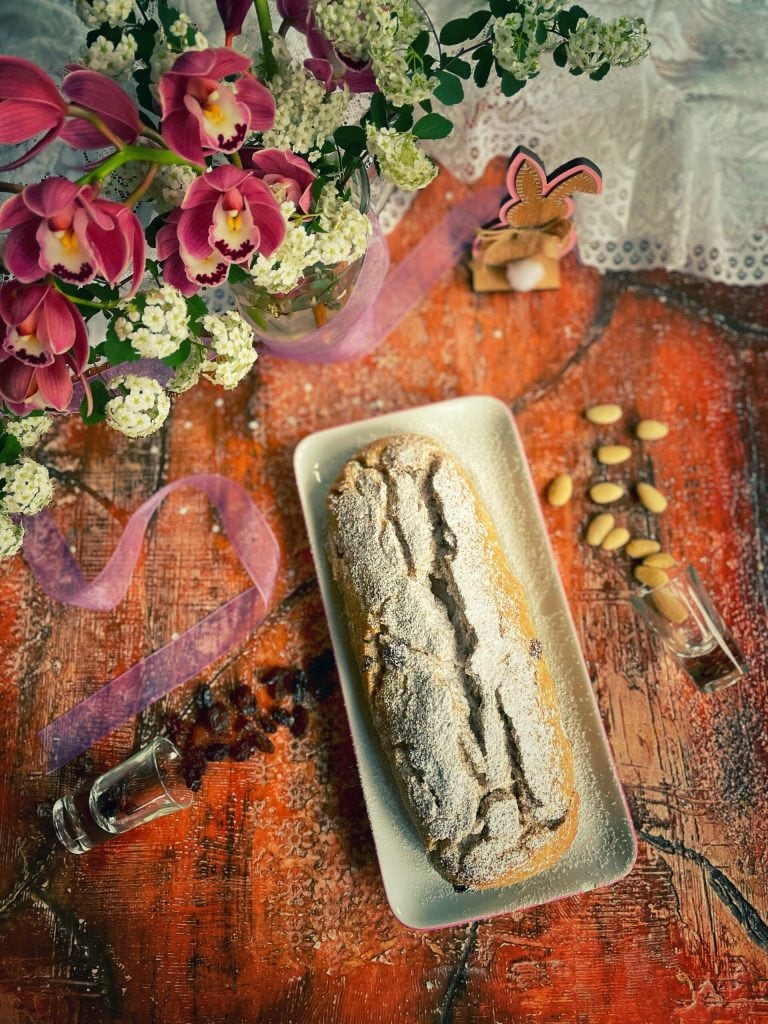The Paasstol, or Paasbrood, is a sweet bread with raisins and often filled with almond paste, typical of Easter in the Netherlands.
Depending on the region or religious context in which it is consumed, Dutch Easter bread has different meanings, shapes, or compositions.
A characteristic of Dutch Easter bread is that, in addition to yeast and flour, butter, it contains eggs, sugar, and raisins, often also candied peel and spices like nutmeg and cinnamon.
Unlike other Easter cakes like the Italian colomba or the British simnel cake, the Paasstol is not a very rich and fluffy leavened dough, but has a more compact texture.
The Dutch Easter bread, the so-called “stol”, is the same type of bread eaten at Christmas, namely the Kerststol.
Both are traditional baked goods from the Netherlands, traditionally associated with Easter for the Paasstol, which accompanies meals or is enjoyed as a snack, and with Christmas for the Kerststol.
I made a simple version, without almond paste filling (in the video my gluten-free version with almond flour and rice flour) and with sourdough.

- Difficulty: Medium
- Cost: Low
- Rest time: 4 Hours
- Preparation time: 15 Minutes
- Portions: 4 People
- Cooking methods: Oven
- Cuisine: European
- Seasonality: Easter
Ingredients
- 4 cups all-purpose flour (for gluten-free version: 2 cups almond flour + 2 cups rice flour)
- 1 cup sourdough starter
- 3.5 oz milk
- 5 tbsp sugar
- 3 oz butter
- 2 eggs
- 1 tsp salt
- 1.5 cups raisins
- 1/2 cup almonds (optional)
- to taste cinnamon
- to taste powdered sugar
Steps
Prepare the dough:
In a large bowl, mix the sourdough starter with lukewarm milk and a teaspoon of sugar to activate it. Let it rest for 10-15 minutes.
Add the flour, remaining sugar, eggs, softened butter, salt, and cinnamon. Start kneading with a fork or wooden spoon, then transfer the dough to a floured surface to knead by hand.
Continue kneading for about 10-15 minutes, until the dough becomes smooth and elastic.
When the dough is ready, add the raisins and chopped almonds. Gently work the dough to evenly distribute the dried fruit.
Form a ball with the dough and place it in a lightly oiled bowl. Cover with a clean towel and let it rise for 2-3 hours, or until the dough has doubled in size.
Once the dough has risen, take it and roll it out on a lightly floured surface to get a rectangle about 3/4 inch thick.
Roll the dough to form a long loaf (similar to a bread loaf). Seal the ends well.
Place the dough on a baking sheet lined with parchment paper.
Cover the dough with a cloth and let it rise for another hour, until it is well puffed.
Preheat the oven to 350°F (static).
Before baking, brush the surface of the Paasstol with some milk or melted butter to achieve a nice golden crust.
Bake for 25-30 minutes or until the Paasstol is golden and sounds hollow when tapped on the bottom.
Once cooked, remove the Paasstol from the oven and let it cool on a wire rack.
Before serving, you can dust it with some powdered sugar for a finishing touch.
FAQ (Frequently Asked Questions)
What are the main differences between Paasstol and Kerststol?
Paasstol: Made to celebrate Easter.
It is mainly eaten during the Easter holidays, usually in the days leading up to Easter, and is a sweet bread that accompanies meals or is enjoyed as a snack.
Traditionally includes raisins, almonds, and sometimes enriched with a filling of almond paste at the center. The recipe may also include cinnamon.
It also has a slightly richer flavor due to the presence of butter and spices.
Kerststol: Made for Christmas. It is a sweet bread traditionally made during the Christmas season.
It is also a leavened bread rich in dried fruits and spices.
It has a similar content of dried fruits (mainly raisins and almonds) but contains an almond paste almond paste inside, which is a distinctive element compared to the Paasstol.
Both breads are leavened, but the Kerststol tends to be richer and fluffier, with a longer and more tapered shape, while the Paasstol has a rounder or oval shape.
Both breads are often brushed with butter and dusted with powdered sugar before being served.
Common ingredients: both are made with dried fruits (especially raisins and almonds), spices like cinnamon, sugar, and yeast.
Almond paste: both the Paasstol and the Kerststol may contain an almond paste or marzipan filling, although the Kerststol contains it more frequently.
Both are leavened sweet breads, but the Paasstol tends to be a bit lighter and less rich compared to the Kerststol, which has a more compact texture.

